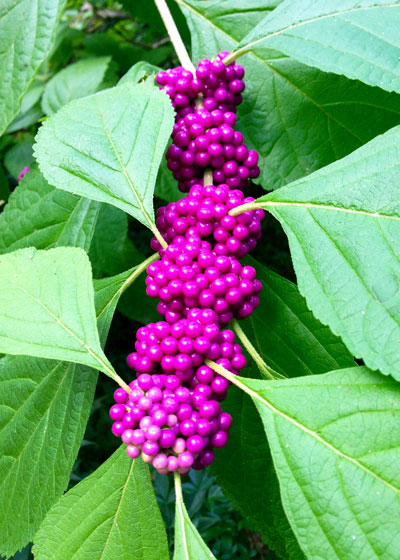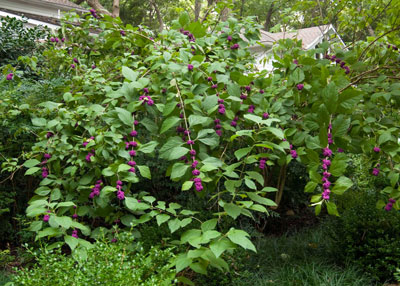Beautiful Berries
I grew up seeing this plant growing everywhere in the post oak forests around College Station. Each fall its fruit clusters would magically turn a brilliant and luminescent near-maroon, fitting (I thought) for where it was growing.

Photo: It would be difficult to stick one more berry into any one of these clusters!
Botanically it’s Callicarpa americana. Horticulturally it’s aptly named as American beautyberry, and I’ve even heard it referred to as “French mulberry” because of the similarity in its leaves to those of the unrelated trees. Whatever the name, beautyberry has a hard time deciding whether it’s a perennial or a shrub. Oh, it grows big enough to be called a shrub, but its open branching and habits of growth leave it looking a little under-qualified to be used as a mainstream shrub against the house. The fact that it’s devoid of leaves through the winter doesn’t help.
I have several beautyberry plants in our gardens, and they show up best when they’re planted in front of dark evergreens like hollies or waxleaf ligustrums. Mine are now 6 to 8 feet tall, but it’s taken many years for that to happen.
The one prerequisite for growing American beautyberries is that their planting soil be kept constantly moist. That reflects back on the plants’ native homes in the wetter parts of Southeast Texas. They are the first plants to show signs of drought in the summer. If you’ve grown hydrangeas, they behave fairly similarly.

Photo: American beautyberries in the Sperry home landscape. It’s taken 20 years for them to attain this height and width.
Little trimming will be needed – probably only to remove an occasional errant branch or two after the fruit is gone. And insects and diseases are almost unheard of with this plant. Since it has large leaves, and since you’ll probably be watering it often, it will benefit from regular applications of high-nitrogen, lawn-type fertilizer.
Beautyberry fruit is attractive to birds and other wildlife, so don’t expect it to remain in place for more than a few weeks. But even though birds will harvest the fruit, the plant doesn’t seem to be especially invasive in landscapes.
Nurseries are well stocked with American beautyberries right now. Wise gardeners hunt for it now. It’s much easier to find American beautyberry in the fall than it will be come spring.
